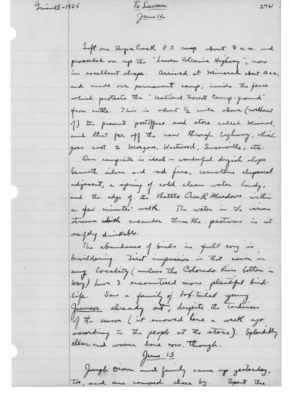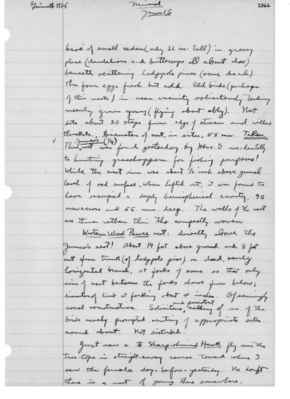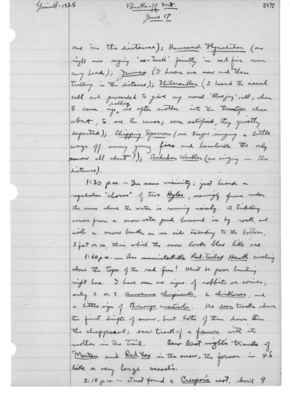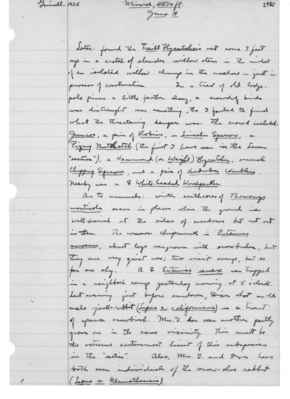Pages That Mention Junco
1925: Joseph Grinnell's field notes
S2 Page 5
Collector: Grinnell - 1925 Location: Lassen Section Date: June 12-13, 1925 Page Number: 2461
Left our Payne Creek P.O. camp about 8 a.m. and proceeded on up the "Lassen Volcanic Highway", now in excellent shape. Arrived at Mineral about 10 a.m., and made our permanent camp, inside the fence which protects the "National Forest Camp-ground" from cattle. This is about 1/2 mile above (northeast of) the present postoffice and store called Mineral, and that far off the new thorough highway, which goes east to Morgan, Westwood, Susanville, etc. Our campsite is ideal - wonderful dryish slope beneath silver and red firs, ceanothus chaparral adjacent, a spring of cold clean water handy, and the edge of the Battle Creek Meadows within a few minutes' walk. The water in the various streams which meander thru the pastures is not safely drinkable. The abundance of birds in full song is bewildering. First impression is that never in any locality (unless the Colorado River bottom in May) have I encountered more plentiful bird life. Saw a family of bob-tailed young Juncos already out, despite the tardiness of the season (it snowed here a week ago according to the people at the store). Splendidly clean and warm here now, though. June 13, 1925. Joseph Dixon and family came up yesterday, too, and are camped close by. Spent the
S2 Page 10
Collector: Grinnell - 1925 Location: Lassen Section (Mineral) Date: June 15, 1925 Page Number: 2466
base of small cedar (only 32 in. tall) in grassy place (dandelions and buttercups all about also) beneath scattering lodgepole pines (some dead). The four eggs fresh but cold. Old birds (perhaps of this nests) in near vicinity solicitously tending nearly grown young (flying about ably). Nest sits about 20 steps from edge of stream and willow thickets. Diameter of nest, in situ, 55 mm. Taken. This Junco's (1/4) nest was found yesterday by Mrs. G incidentally to hunting grasshoppers for fishing purposes! While the nest rim was about 1/2 inch above general level of sod surface, when lifted out, it was found to have occupied a deeply hemispherical cavity. 90 mm. across and 55 mm. deep. The walls of the nest are thus rather thin this compactly woven. Western Wood Pewee nest: directly above the Junco's nest! About 14 feet above ground and 7 feet out from trunk (of lodgepole pine) on dead, nearly horizontal branch, at forks of same so that only rim of nest between the forks shows from below; diameter of limb at forking about 4 inches. Of seemingly usual construction. Solicitous and persistent calling of one of the birds nearly prompted scrutiny of appropriate sites round about. Not disturbed. Just saw a male Sharp-shinned Hawk fly over the tree-tops in straight-away course toward where I saw the female day-before-yesterday. No doubt there is a nest of young there somewhere.
S2 Page 17
Collector: Grinnell - 1925 Location: Lassen Section (Brokeoff Mt.) Date: June 17, 1925 Page Number: 2472
one in the distance); Hammond Flycatcher (one right now saying "see-Tuck" faintly in red fir over my head); Junco (I hear one now and then trilling in the distance); Nutcracker (I heard the nasal call and proceeded to give my usual "bluejay" call, when 5 came up, calling, one after another into the treetops close about, to see the cause; soon satisfied, they quietly departed); Chipping Sparrow (one keeps singing a little way off away young firs and hemlocks the only snow all about!); Audubon Warbler (one singing in the distance). 1:30 p.m. - In same vicinity; just heard a regulation "chorus" of two Hylas, seemingly from under the snow where the water is running noisily. A tributary comes from a snow-water pond hemmed in by rock, and with a snow bank on one side extending to the bottom, 3 feet or so, thru which the snow looks blue like ice. 1:50 p.m. - An unmistakable Red-Tailed Hawk circling above the tops of the red firs! Must be poor hunting right here. I have seen no signs of rabbits or conies; only 2 or 3 Amoenus Chipmunk, 2 chickadees, and a little sign of Thomomys monticola. No deer tracks above the first drifts of snow, but lots of them down thru the chaparral; saw track of a fawn with its mother in the trail. Saw last night's tracks of Marten and Red Fox in the snow, the former in 4's like a very large weasel's. 2:15 p.m. - Just found a Creeper's nest, about 9
S2 Page 24
Collector: Grinnell-1925 Location: Mineral, 4800 ft. Date: June 19 Page Number: 2479
and the structure is ensconced in a tangle of dead twiggery in part supported by slanting ceanothus cordulatus stems - in a thicket of same - well shaded by green leafage above.
9:30 a.m. - Just followed a Ruby-crowned Kinglet's "yerruping," and found a pair upon the summit of a fir assaulting vigorously a Blue-fronted Jay. Nearby, a (female) Western Tanager was flying about and at another jay in the top of a fir. One of the Blue-fronted Jays seen plainly was a full-grown young-of-the-year.
10: a.m. - Mrs. G. just found a Yellow Warbler's nest, 8 feet up, saddled on crossing stems in midst of willow thicket on meadow - perfectly typical site and construction for the species. Contents, 2 fresh eggs.
10:45 a.m. - Across the highway from camp, on a portion of Battle Creek Meadows that has had no cattle on it yet this year; grass and flowers a foot high; blue camas abundant in places; here and there clumps of willow; and many lodgepole pines, singly now and then, or in tracts. Birds I hear are: Western Meadowlark, two in full song; Robin, 2 or more in song; Lazuli Bunting, 2 singing; Warbling Vireo (one singing); Audubon Warbler (a (female) close by in a l-p pine); Calif. Purple Finch (one singing); Junco (one singing); Traill Flycatcher (pair close to me, and Mrs. G has seen one carrying a billfull of something into the midst of a willow thicket and in investigating); Lincoln Sparrow (a singing male centers within 3 acres about us).
S2 Page 25
Author: Grinnell-1925 Location: Mineral, 4800 ft. Date: June 19 Page Number: 2480
Later: found the Traill Flycatcher's nest some 7 feet up in a crotch of slender willow stem in the midst of an isolated willow clump in the meadow - just in process of construction. In a tract of old lodge pole pines a little farther along, a crowd of birds was distraught over something, tho I failed to find what the threatening danger was. The crowd included: Juncos, a pair of Robins, a Lincoln Sparrow, a Pigmy Nuthatch (the first I have seen in the Lassen "section"), a Hammond (or Wright) Flycatcher, several Chipping Sparrows, and a pair of Audubon Warblers. Nearby was a (female) White-headed Woodpecker.
As to mammals: winter earthcores of Thomomys monticola occur in places where the ground is well-drained at the sides of meadows but not out in them. The common chipmunk is Eutamias amoenus, about logs overgrown with snowbushes, but they are very quiet now; two visit camp, but so far are shy. A (female) Eutamias senex was trapped in a neighbor's camp yesterday morning at 5 o'clock. Last evening just before sundown, Dixon shot an old male jack-rabbit (Lepus c. californicus) in a tract of sparse snowbush. Mrs. G. has seen another partly grown one in the same vicinity. This must be the extreme easternmost limit of this subspecies in the "section". Also, Mrs. G. and Dixon have both seen individuals of the snow-shoe rabbit (Lepus w. klamathensis).




